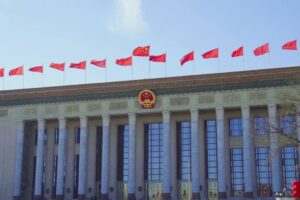
Taiwan is now a geopolitical hot spot. Bloomberg Economics assesses the global economic impact of a war on Taiwan at $10 trillion, far surpassing the hit from the war in Ukraine or the COVID-19 pandemic. Some nations are attempting, both economically and militarily, to dissuade China from reunifying Taiwan by force. In fact, the best deterrent is to make China aware of the potentially unbearable demographic consequences of war.
Demographic consequences of the war between Russia and Ukraine
The loss of life in the war between Russia and Ukraine goes beyond the hundreds of thousands of military and civilian deaths. There has also been a marked decline in births in both countries.
After the collapse of the Soviet Union, Russia’s fertility rate fell from 1.89 births per woman in 1990 to 1.16 in 1999, which President Vladimir Putin has described as a “national crisis.” For decades, he has warned that Russia is on a path to extinction. In 2006, Putin declared the need to address population decline as “the top national priority.” Thanks to the government’s generous anti-crisis measures and relatively friendly international relations, the Russian economy grew at an average annual rate of 5 percent from 2000 to 2013, and the fertility rate rose to 1.78 in 2015.
But Russia seized Crimea in 2014, incurring Western sanctions. As a result, Russia’s economy grew at an average annual rate of just 0.7 percent during 2014-2022, and births fell from 1.94 million in 2015 to 1.4 million in 2021. In Ukraine, the fertility rate fell from 1.51 in 2015 to 1.16 in 2021, due to the economic downturn partially caused by the significant resources devoted to war preparation.
Russia’s large-scale invasion of Ukraine in 2022 further reduced births in Russia, to 1.26 million in 2023. In Ukraine, family separation and economic hardship led to a further decline in the fertility rate to 0.7 per cent. same year. If Russia and Ukraine had stabilized their fertility rates at 2015 levels, there would have been 1.8 million and 600,000 more births, respectively, in 2016-2023 than actually occurred.
Russia’s geopolitical situation is worse than before the war, its economic outlook is bleak, and its population will decline rapidly. Putin’s hopeful dream of national rejuvenation will eventually end in a nightmare.
Russia’s invasion has been a demographic catastrophe for Ukraine. The combination of emigration, war casualties and low fertility rate has reduced Ukraine’s population from 45.4 million in 2014 to 33-35 million today. The mass exodus of women and children will lead to a continuation of the decline in births after the war. Labor shortages, aging and disability will make reconstruction after the war very difficult, so the fertility rate will not recover much.
China and Taiwan are already facing demographic problems
Taiwan’s average fertility rate was only 1.15 during 2000-2021, lower than Ukraine’s, which was 1.33, and only 0.87 in 2022. Taiwan’s National Development Council projects that if the fertility rate stabilizes at 0.9, Taiwan’s population will decline from 23 million in 2023 to 15 million in 2070.
On February 29, China’s National Bureau of Statistics released population figures for 2023, with only 9.02 million births and a fertility rate of just 1.0, well below the official forecast of 15.5 million and the lowest number of births. since 1762, when the total population was only 200 million. Last year, China officially acknowledged that its population would shrink in 2022 for the first time in 60 years, nine years earlier than government projections had anticipated.
The implications of these data are difficult to overstate. This means that China’s demographic crisis is much worse than expected. As a result, all of China’s economic, foreign, and defense policies are based on flawed demographic data.
The median age in Taiwan and China increased from 23 and 22 in 1980 to 45 and 43 in 2024, respectively, and will continue to increase to 58 and 57 in 2050. While in 2020 China and Taiwan had five and four workers aged 20 to 64 for every person over 65, respectively, the ratio will continue to decline to 1.5 and 1.3 in 2050. Amid an aging population and declining workforce, Taiwan’s average annual economic growth rate declined from 9 percent in 1960 -2000 to 3 percent in 2015-2023, and China’s from 10 percent in 1980-2011 to 5 percent in 2020-2023.
The Taiwan Semiconductor Manufacturing Company Limited, a chip manufacturing giant founded in 1987, produces about 90 percent of the world’s advanced chips, giving Taiwan considerable weight in international geopolitics. But aging is causing a decline in Taiwan’s innovation capacity, resulting in a waning presence in emerging global high-tech industries. Taiwan’s potential military service population of men aged 18 to 35 has declined from 3.5 million in 1999 to 2.7 million in 2023 and will continue to decline to 2 million in 2035 and 1.4 million in 2050. In other words, its demographic crisis suggests that Taiwan’s technological importance will decline rapidly and its defense will become increasingly dependent on the United States, turning it from a strategic partner to a strategic liability.
Both mainland China and Taiwan are facing economic stagnation and are losing the demographic and economic foundations of their long-standing rivalries. They need to focus on their respective demographic challenges.
Demographic Consequences of a War in Taiwan
If China and Taiwan went to war, the demographic implications would be enormous, and unbearable.
In the event of a war in Taiwan, large numbers of people would flee. If China fails to take Taiwan quickly, both sides will descend into a long-term military confrontation. Taiwan will be exhausted from preparing for war; Industrial chains and foreign investment will withdraw, resulting in an economic recession and a sharp drop in the birth rate. If Taiwan were taken over by China, its political, economic and demographic prospects would be even bleaker than those of Hong Kong.
Chinese authorities may be proud of having thwarted anti-extradition protests in Hong Kong in 2019 and successfully implementing the national security law in 2020. However, they ignore the enormous cost: weakening Hong Kong’s status as a financial center , destroying the bridge between China and the West, and above all the massive loss of population. By mid-2022, there were 180,000 fewer people aged 20 to 39 in Hong Kong than two years earlier. Political arrogance and the zero-COVID policy together led to an economic recession, with births falling from 53,000 in 2019 to 33,000 in 2022, and a fertility rate falling from 1.06 to 0.70.
Whether China wins a war in Taiwan or not, it is destined to be sanctioned by the West, and its geopolitical environment will worsen, resulting in fewer exports, rising unemployment, and falling fertility rates. All of China’s efforts so far to increase its fertility rate have had little impact; nothing you can do will compensate for the further decline in the fertility rate caused by a war in Taiwan. Assuming China can stabilize its fertility rate at 0.7, its population will fall to 1.01 billion in 2050 and 280 million in 2100, accounting for 11 percent and 3 percent of the total world population.
The consequences would not be limited to China and Taiwan. Russia’s invasion of Ukraine has led to rising energy prices, economic slowdowns and high inflation in Europe, reducing births. In 2023, there were 11 percent and 7 percent fewer births in Poland and Germany, respectively. With an economy 10 times larger than Russia’s, China is currently the largest trading partner for more than 140 economies. A war in Taiwan would lead to a global recession, as well as declining fertility rates in many countries, especially South Korea and Japan.
The United States, with a fertility rate that fell from 2.1 in 2007 to 1.6 in 2023, also faces an economic slowdown caused by aging, although not as severe as that of its allies, including Canada, the United Kingdom, Australia, New Zealand, the European Union, Japan and South Korea. Their combined share of the global economy fell from 77 percent in 2003 to 56 percent in 2023, and that trend will continue. If a war breaks out in Taiwan, it will accelerate these trends, leading to global instability and even the collapse of the US-led world order.
Time is not on the side of China or Taiwan, nor is it on the side of the United States. The three sides need to show enough wisdom and courage to achieve permanent peace in the Taiwan Strait, and avoid falling off a demographic cliff.
Note: this is an article republished from “The Diplomat” through a cooperation agreement between both parties for the dissemination of journalistic content. Original link.
Yi Fuxian (易富贤) is a demographer and researcher in obstetrics and gynecology (OB/GYN) at the University of Wisconsin-Madison and author of the book “Great Empty Nest Country,” which criticized China’s birth policies.
Source: https://reporteasia.com/opinion/2024/04/12/costo-demografico-guerra-taiwan/

